“Data-driven modeling of skin and muscle deformation” by Park and Hodgins
Conference:
Type(s):
Title:
- Data-driven modeling of skin and muscle deformation
Presenter(s)/Author(s):
Abstract:
In this paper, we present a data-driven technique for synthesizing skin deformation from skeletal motion. We first create a database of dynamic skin deformations by recording the motion of the surface of the skin with a very large set of motion capture markers. We then build a statistical model of the deformations by dividing them into two parts: static and dynamic. Static deformations are modeled as a function of pose. Dynamic deformations are caused by the actions of the muscles as they move the joints and the inertia of muscles and fat. We approximate these effects by fitting a set of dynamic equations to the pre-recorded data. We demonstrate the viability of this approach by generating skin deformations from the skeletal motion of an actor. We compare the generated animation both to synchronized video of the actor and to ground truth animation created directly from the large marker set.
References:
1. Allen, B., Curless, B., and Popović, Z. 2002. Articulated body deformation from range scan data. ACM Transactions on Graphics 21, 3, 612–619. Google ScholarDigital Library
2. Angelidis, A., and Singh, K. 2007. Kinodynamic skinning using volume-preserving deformations. In Proceedings of ACM SIGGRAPH/Eurographics Symposium on Computer Animation, 129–140. Google ScholarDigital Library
3. Anguelov, D., Srinivasan, P., Koller, D., Thrun, S., Rodgers, J., and Davis, J. 2005. SCAPE: shape completion and animation of people. ACM Transactions on Graphics 24, 3, 408–416. Google ScholarDigital Library
4. Atkeson, C. G., Moore, A. W., and Schaal, S. 1997. Locally weighted learning. Artificial Intelligence Review 11, 1–5, 11–73. Google ScholarDigital Library
5. Barbic, J., and James, D. L. 2005. Real-time subspace integration for St. Venant-Kirchhoff deformable models. ACM Transactions on Graphics 24, 982–990. Google ScholarDigital Library
6. Cheung, K. M., Baker, S., and Kanade, T. 2003. Shape-from-silhouette of articulated objects and its use for human body kinematics estimation and motion capture. In Proceedings of the IEEE Conference on Computer Vision and Pattern Recognition. Google ScholarDigital Library
7. Choi, M. G., and Ko, H.-S. 2005. Modal warping: real-time simulation of large rotational deformation and manipulation. IEEE Transactions on Visualization and Computer Graphics 11, 1, 1077–2626. Google ScholarDigital Library
8. Der, K. G., Sumner, R. W., and Popović, J. 2006. Inverse kinematics for reduced deformable models. ACM Transactions on Graphics 25, 3, 1174–1179. Google ScholarDigital Library
9. Guo, Z., and Wong, K. C. 2005. Skinning with deformable chunks. Computer Graphics Forum 24, 3, 373–382.Google ScholarCross Ref
10. Hyun, D.-E., Yoon, S.-H., Chang, J.-W., Seong, J.-K., Kim, M.-S., and Jüttler, B. 2005. Sweep-based human deformation. The Visual Computer 21, 8–10, 542–550.Google ScholarCross Ref
11. James, D. L., and Pai, D. K. 2002. DyRT: dynamic response textures for real time deformation simulation with graphics hardware. ACM Transactions on Graphics 21, 3, 582–585. Google ScholarDigital Library
12. Kavan, L., and Zara, J. 2005. Spherical blend skinning: A real-time deformation of articulated models. In Proceedings of ACM SIGGRAPH Symposium on Interactive 3D Graphics and Games, 9–16. Google ScholarDigital Library
13. Kry, P. G., James, D. L., and Pai, D. K. 2002. Eigenskin: Real time large deformation character skinning in hardware. In Proceedings of ACM SIGGRAPH / Eurographics Symposium on Computer Animation, 153–160. Google ScholarDigital Library
14. Lewis, J. P., Cordner, M., and Fong, N. 2000. Pose space deformations: A unified approach to shape interpolation and skeleton-driven deformation. In Proceedings of ACM SIGGRAPH 2000, 165–172. Google ScholarDigital Library
15. Mohr, A., and Gleicher, M. 2003. Building efficient, accurate character skins from examples. ACM Transactions on Graphics 22, 3, 562–568. Google ScholarDigital Library
16. Nedel, L. P., and Thalmann, D. 2000. Anatomic modeling of deformable human bodies. The Visual Computer 16, 6, 306–321.Google ScholarCross Ref
17. Nigg, B. 1999. The effect of muscle stiffness and damping on simulated impact force peaks during running. Journal of Biomechanics 32, 8, 849–856.Google ScholarCross Ref
18. Park, S. I., and Hodgins, J. K. 2006. Capturing and animating skin deformation in human motion. ACM Transactions on Graphics 25, 3, 881–889. Google ScholarDigital Library
19. Pratscher, M., Coleman, P., Laszlo, J., and Singh, K. 2005. Outside-in anatomy based character rigging. In Proceedings of ACM SIGGRAPH / Eurographics Symposium on Computer Animation, 329–338. Google ScholarDigital Library
20. Sand, P., McMillan, L., and Popović, J. 2003. Continuous capture of skin deformation. ACM Transactions on Graphics 22, 3, 578–586. Google ScholarDigital Library
21. Scheepers, F., Parent, R. E., Carlson, W. E., and May, S. F. 1997. Anatomy-based modeling of the human musculature. In Proceedings of ACM SIGGRAPH 97, 163–172. Google ScholarDigital Library
22. Teran, J., Sifakis, E., Irving, G., and Fedkiw, R. 2005. Robust quasistatic finite elements and flesh simulation. In ACM SIGGRAPH/Eurographics Symposium on Computer Animation, 181–190. Google ScholarDigital Library
23. Wang, X. C., and Phillips, C. 2002. Multi-weight enveloping: Least-squares approximation techniques for skin animation. In Proceedings of ACM SIGGRAPH / Eurographics Symposium on Computer Animation, 129–138. Google ScholarDigital Library
24. Wilhelms, J., and Gelder, A. V. 1997. Anatomically based modeling. In Proceedings of ACM SIGGRAPH 97, 173–180. Google ScholarDigital Library





